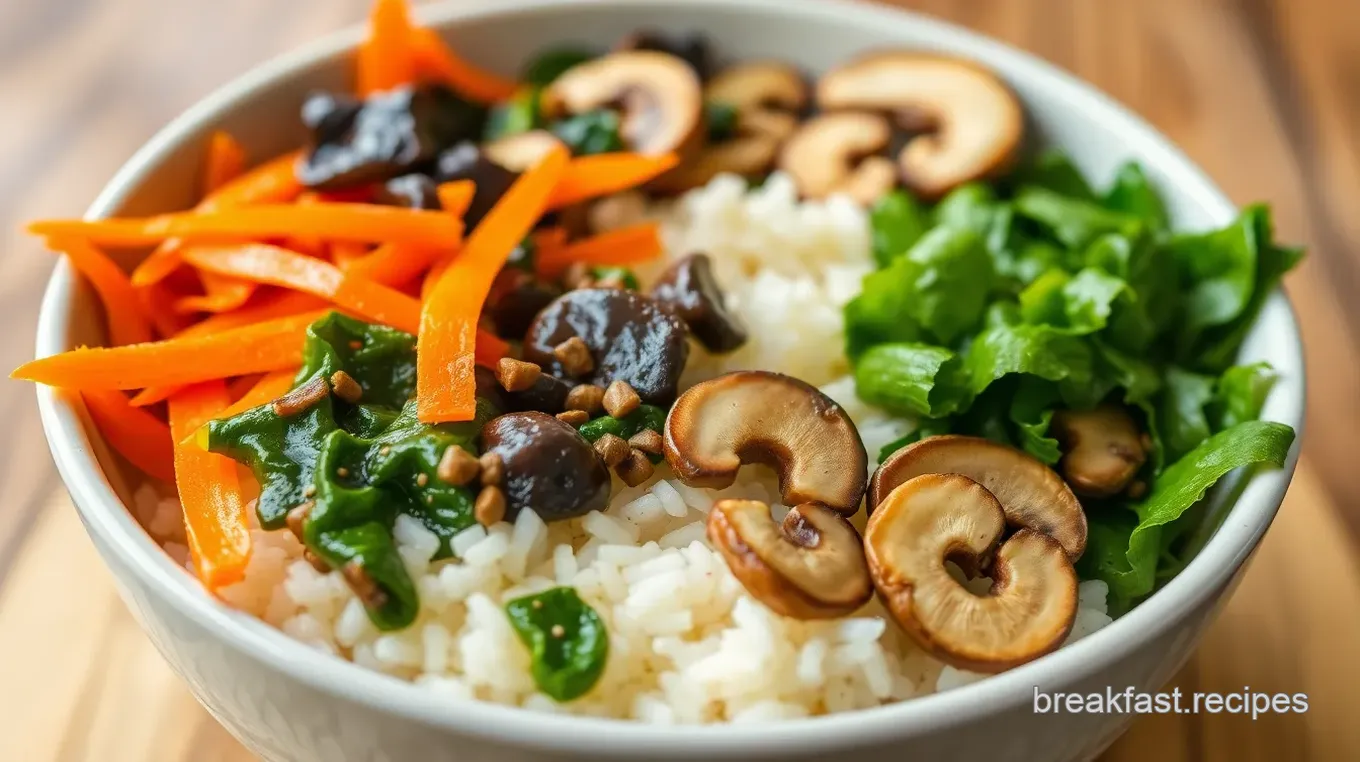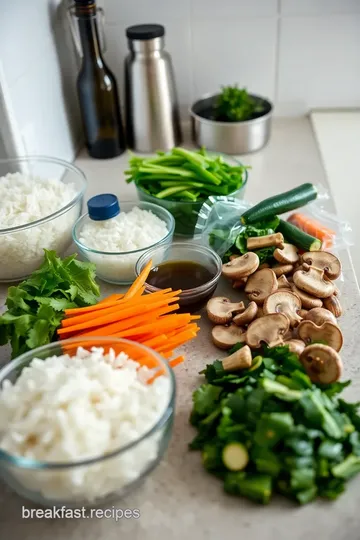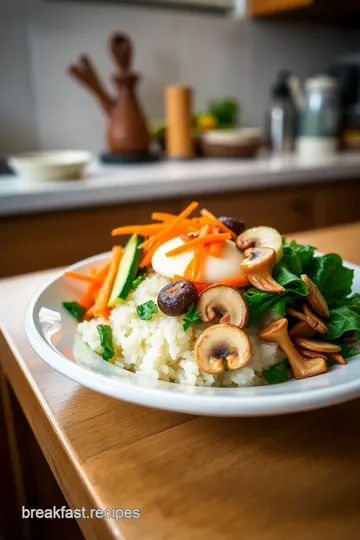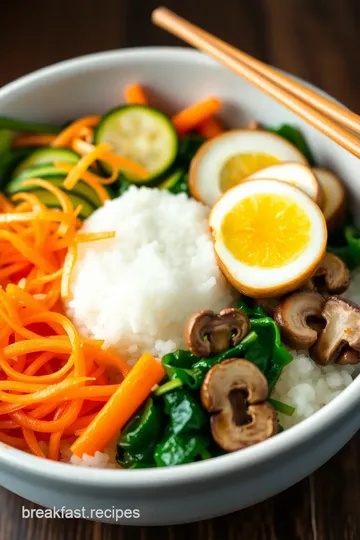Quick Bibimbap: Flavorful Korean Breakfast Bowl
Craving a quick and nourishing meal? Try my Quick Bibimbap: Flavorful Korean Breakfast Bowl that's perfect for busy mornings! Check out the recipe now!

- A Breakfast Bowl Designed to Satisfy
- Recipe Overview: The All-in-One Wonder
- Key Benefits: Why You’ll Love Bibimbap
- Essential Ingredients Guide to Quick Bibimbap: Flavorful Korean Breakfast
- Mastering the Art of Quick Cooking with Bibimbap
- Pro Tips & Secrets for Your Quick Bibimbap: Flavorful Korean Breakfast
- Frequently Asked Questions
- Recipe Card
A Breakfast Bowl Designed to Satisfy
Have you ever had one of those mornings when you just want something quick but super delicious to kickstart your day? picture this: it's a busy weekday, the sun's barely up, and you're racing against the clock.
I remember one particularly hectic morning when i strolled into my kitchen feeling like a zombie. that’s when i discovered quick bibimbap: flavorful korean breakfast , and oh my gosh, it was a game-changer! it’s like the popular korean breakfast that hugs you with flavor and nutrition.
Talk about a breakfast bowl that pulls double duty — delicious and healthy!
This dish isn’t just pretty and tasty; it’s packed with so much nutritional value of bibimbap that you’ll feel great about serving it.
The classic bibimbap has roots going back to the joseon dynasty, bringing together various ingredients into one harmonious bowl. now, it’s found its way into modern kitchens everywhere, from your local cafe to foodie hubs like seoul street food markets.
Honestly, it’s one of those easy bibimbap recipes that totally deserves a place in your meal rotation.
Recipe Overview: The All-in-One Wonder
So, how does this quick bibimbap work? well, it’s super easy. you’ll be in and out of the kitchen in about 30 minutes .
Yup, that’s right — we’re talking prep time of 15 minutes and another 15 to cook. it serves two, so it's perfect for those mornings when you want to whip up a quick meal for yourself or someone special.
Money-wise, it won’t break the bank. most of the ingredients are staples you may already have lurking in your pantry or fridge.
Think of fluffy rice recipes and seasonal veggies. plus, you can customize it! feeling fancy? add some marinated beef or an extra bowl for the kids.
Key Benefits: Why You’ll Love Bibimbap
I get it, time is of the essence, but let’s not forget about the good stuff ! this healthy breakfast bowl provides a ton of energy to get you through the day.
Packed with fresh vegetables like zucchini, spinach, and carrots, this bowl is like a rainbow in your dish. and those colorful vegetables? they come with plenty of vitamins and minerals!
Plus, the spicy korean dishes like gochujang add that necessary kick to wake up your taste buds! you can't talk about bibimbap without mentioning toppings! think sesame seeds and sunny-side-up eggs that add richness to every bite.
A sprinkle of kimchi on the side? heck yeah! it’s perfect for special occasions or just a random tuesday.
And let’s be honest — isn’t there something about a one bowl meal that makes life simpler? just throw everything in there, mix it up, and dig in.
It’s not only quick and delicious, but it's also great for meal prep bibimbap-style for those chaotic workweeks. just heat it up and you’re good to go!
With customizable bibimbap , you can use whatever veggies you have on hand or tap into your cravings. it’s kinda like the versatile cousin of the breakfast world, and you never know, it might just win over your heart (and stomach) too.
So, are you ready to jump into the delicious details? Let’s take a look at the ingredients you’ll need to pull off this bad boy!

Essential Ingredients Guide to Quick Bibimbap: Flavorful Korean Breakfast
Oh my gosh! if you're diving into the world of korean breakfast ideas , you've gotta check out quick bibimbap.
It's this absolutely vibrant and colorful breakfast bowl that manages to pack a whole lot of flavors into a single serving.
Honestly, it’s like a party in your mouth! let’s break down some essential ingredients you’ll need for this easy bibimbap recipe.
Premium Core Components
First off, you need good rice. for this dish, 2 cups cooked short-grain rice (that’s about 400g if you’re measuring) will do wonders.
Make sure it’s fluffy! to get that perfect fluffiness, rinse your rice until the water runs clear. that way, you can dodge the dreaded clumpiness later on.
Next, consider your veggies. you’ve gotta have 1 cup baby spinach (roughly 30g), 1 small zucchini (150g), and 1 medium carrot (70g)—all sliced up and ready to go.
When picking veggies, look for vibrant colors and freshness; they should just shout “eat me!” and remember, veggies can last a bit in the fridge but aim to use them within a week for the best taste.
Now, the star of the show is the gochujang . this magical korean chili paste adds a zing to your quick bibimbap.
If it’s not glossy and vibrant red, it’s not the good stuff. store it in a cool spot, and it’ll chill in your fridge for ages.
Signature Seasoning Blend
When it comes to seasonings, don’t skimp! for your signature blend, you’ll need 2 tablespoons gochujang, 1 tablespoon sesame oil (which gives a nutty flavor), plus some sesame seeds for that final touch.
You can mix it up with other spices according to your mood—like garlic or even a sprinkle of soy sauce.
Remember, spices can be super regional too. if you're feeling adventurous, try adding some korean flavors that match your local favorites!
Smart Substitutions
Running low on supplies? no problem! for the rice, you can swap out short-grain for any rice you have on hand.
Brown rice works wonderfully, or even quinoa for a protein kick. when it comes to veggies, feel free to get creative.
Got some leftover bell peppers or mushrooms? toss them in!
And if you’re doing the whole dietary modification thing, just switch the egg for tofu. you can make a vegetarian bibimbap and it's just as delicious.
Let me tell you, my first try making one was a blast!
Kitchen Equipment Essentials
Here’s the deal. you don’t need fancy gadgets for this recipe. a non-stick skillet is a must; it’ll help avoid any kitchen drama when cooking your eggs sunny-side up! if you don’t have one, a regular skillet will do, just keep an eye on it.
Also, for those veggies, a steamer or a pot will serve you well. Blanching your bean sprouts takes only 1- 2 minutes , so don't forget to drain them afterwards.
Now, let’s chat about storage. Store any leftovers in airtight containers, and they’ll be good for about 3-4 days. Honestly, leftover bibimbap can make for an easy on-the-go breakfast!
So now that we’ve covered the essentials, are you ready to dive into making your own quick bibimbap? it’s such a fulfilling dish that can be loaded up with whatever toppings you desire—think kimchi side dishes, crunchy veggies, and proteins .
Plus, it makes for a fantastic way to kick off your day while getting that nutritional value of bibimbap you want.
Let’s jump into the step-by-step instructions and create a breakfast bowl that's not just a meal but a whole experience.

Mastering the Art of Quick Cooking with Bibimbap
When it comes to professional cooking methods , it’s all about the rhythm and flow in the kitchen. whether you're seasoned or just starting, the key is in the preparation.
Let’s dive into the essential steps to whip up a delicious quick bibimbap: flavorful korean breakfast that’ll knock your socks off.
Essential Preparation Steps
First off, we have mise en place , which is just a fancy french term that means “everything in its place.
” get your ingredients ready ahead of time. trust me, it makes cooking way easier. you'll need some short-grain rice , veggies (like zucchini and carrots), and those vibrant bibimbap toppings ready to go.
Now, let’s talk time management. aim for 15 minutes of active prep and 15 minutes of cooking total.
If you can make timers your best friend, you'll sail through this. set your first timer for that rice, then get those veggies sizzling!
And organization? oh boy, it’s key! lay out your tools and ingredients. arrange your cooking station; put the non-stick skillet right where you can reach it.
It keeps you focused and speeds things up. don't forget to keep safety in mind—always handle hot surfaces with care and keep those sharp knives away from little fingers!
Step-by-Step Process
Ready for the fun part? Here’s how to do it, step by step:
- Prep the Rice: Reheat 2 cups of cooked short-grain rice if it’s not fresh.
- Sauté the Vegetables: Heat 1 tablespoon of oil in your skillet over medium heat. Sauté the zucchini for 2- 3 minutes until it’s tender. Remove it, then do the same for the carrots and spinach; they only need about 2 minutes each.
- Blanch the Bean Sprouts: Toss those bean sprouts in boiling water for 1- 2 minutes to get them tender and crunchy. Drain and set aside.
- Cook the Eggs: In the same skillet, heat another tablespoon of oil , crack in 2 large eggs , and cook until the whites are set but the yolks are still runny (about 3- 4 minutes ).
- Assemble Your Bibimbap: Layer your rice in a bowl, then pile on the veggies, finishing with that glorious sunny-side-up egg.
- Finish with Dressing: Drizzle with sesame oil and a hefty spoonful of gochujang . Sprinkle on sesame seeds and optional green onions.
- Serve Immediately: Before diving in, mix everything up for that perfect bite!
Expert Techniques
Now, for those expert tips! when it comes to temperature control , keep your skillet on medium heat. too hot, and your veggies might burn instead of getting that perfect sauté.
Make sure you watch the timing too—those veggies need quick cooking; we want ‘em tender but still colorful!
Keep an eye on the quality; if your vegetables start wilting too much, you might end up with a soggy bibimbap—a big no-no! feel free to troubleshoot if things don’t look right.
If you overcooked anything, just serve it with a spoon of extra gochujang and be bold!
Success Strategies
Okay, let's be real—mistakes happen! a common goof is burning the rice. if you’re using a rice cooker, set it and forget it.
For stovetop, don’t go anywhere! for guaranteed perfect results, always taste as you go . you can adjust the seasoning based on your personal taste.
Thinking about make-ahead options ? you can prep all your veggies the night before and store them in the fridge.
Just avoid cooking the eggs until right before serving to keep that silky texture perfect!
Additional Information
With a bowl of this quick bibimbap , you're diving into a slice of korean cuisine home cooking that’s not just tasty but also packed with nutrients.
Each ingredient contributes to a healthy breakfast bowl that's customizable based on what’s in your fridge. whether you're whipping it up on a busy morning or prepping for the week, this dish is everything you need to fuel your day.
And hey, don’t forget to serve it with a side of kimchi for a pop of flavor and health benefits!
Go ahead, give this easy bibimbap recipe a try and experience the flavors that remind you of vibrant Seoul street food. You’ll be hooked on this fabulous rice dish in no time!

Pro Tips & Secrets for Your Quick Bibimbap: Flavorful Korean Breakfast
So, you’ve decided to spice up your mornings with this quick bibimbap: flavorful korean breakfast , huh? i love it! trust me when i say, cooking can be a breeze with a few nifty tips.
First up, let’s chat about some pro tips that can make this dish not just any dish—it's gotta be the best!
Chef's Personal Insights
One thing i learned from my mom? don’t rush the sautéing ! give those veggies time to release their flavors.
Spinach needs just a couple minutes, but zucchini? three’s good. this patience really pays off when it comes to building that umami flavor profile everyone’s after.
Time-Saving Techniques
If you’re short on time, use pre-cooked rice . great decision! you can whip this up in under 30 minutes if you grab leftover rice from last night’s dinner.
Lunches can be a breeze too with this one—think about packing a quick meal for work!
Flavor Enhancement Tips
Wanna kick it up a notch? adjust that gochujang to your liking! it can be a delightful kick or a gentle embrace of spice.
If you're feeling adventurous, squeeze in a little lime juice for zing. also, don't shy away from sesame oil. a drizzle over the top makes everything come alive.
Perfect Presentation
Let’s not just leave it at taste, though; eat with your eyes first!
Plating Techniques
For dazzling presentation, layer your bibimbap like a pro. Start with a generous scoop of that fluffy short-grain rice as the base. Layer the sautéed veggies in a vibrant rainbow.
Garnish Ideas
Sprinkle some sesame seeds on top, and if you're feeling fancy, add chopped green onions for that pop of color and freshness. Voila! You now have your very own Korean breakfast masterpiece.
Color Combinations
Use varied colors for the veggies—bright orange from carrots, rich green from spinach, and the lovely cream from the egg.
It makes your breakfast bowl tempting and showcases the nutritional value of bibimbap .
Storage & Make-Ahead
Ever wonder how to make busy mornings easier?
Storage Guidelines
This dish is a breeze to store ! put any leftovers in an airtight container and stick it in the fridge.
It’s good for about three days . just make sure to keep the egg separate until you reheat.
Reheating Instructions
When you’re ready to enjoy again, just nuke it in the microwave for a minute or two. You can even pop that sunny-side-up egg on top in the last minute for a perfect finish!
Creative Variations
You can seriously make this bibimbap your own!
Flavor Adaptations
Feeling like a protein boost? Toss in some marinated beef, chicken, or even tofu , and you've got yourself a filling meal.
Dietary Modifications
For those who want a vegetarian bibimbap, skip the meat and load it with even more fresh veggies. Fun fact: the more colorful your bowl, the healthier it is!
Seasonal Twists
Seasonality matters! Swap in some zucchini for sweet potatoes in the fall or use roasted vegetables in colder months. Fresh vegetable meals make the best dishes!
Complete Nutrition Guide
Now, let's talk about why this Quick Bibimbap rocks.
Detailed Breakdown
Each serving? Packed with 14 grams of protein and a balanced blend of fats and carbs. You get the perfect healthy breakfast bowl , equipping you for a busy day!
Health Benefits
Did you know that bibimbap can boost your energy levels? With short-grain rice and lots of vegetables, it’s a nutritional powerhouse. Plus, that gochujang sauce has health benefits with its fermented ingredients.
Portion Guidance
Don’t fret about portions either! You can easily adjust the ingredients based on how hungry you are. Want a bigger breakfast? Double up on the rice or add an extra egg!
So there you go! whether you want korean breakfast ideas, quick meal inspiration, or a tasty way to embrace korean cuisine at home, you can be confident whipping this up.
Embrace the mess, enjoy the flavors, and remember: cooking should be fun! now go grab those veggies and get started on your own quick bibimbap ! it’s not just a meal; it’s a celebration of flavor!
Frequently Asked Questions
What is Quick Bibimbap: Flavorful Korean Breakfast?
Quick Bibimbap is a simplified version of the traditional Korean dish, featuring cooked rice topped with sautéed vegetables, a sunny-side-up egg, and a spicy gochujang sauce. It's a colorful and nutrient-dense breakfast option that can be prepared in under 30 minutes, making it perfect for busy mornings.
Can I customize the vegetables in my Quick Bibimbap?
Absolutely! While the recipe includes spinach, zucchini, carrots, and bean sprouts, you can easily swap in other vegetables like mushrooms, bell peppers, or bok choy depending on your preference or what's in season. Just adjust the cooking times to ensure everything is tender.
How do I store leftovers from my Quick Bibimbap?
If you have leftovers, store the components separately for the best texture. Refrigerate the rice and vegetables in airtight containers and consume within 2-3 days. When ready to eat, you can reheat the rice and vegetables, and top them with a new sunny-side-up egg.
What are some variations or substitutions for the ingredients in Quick Bibimbap?
You can enhance your bibimbap with protein such as cooked beef, chicken, or tofu for a heartier meal. If you can't find gochujang, consider using a mix of red chili paste and soy sauce as a substitute. The sunny-side-up egg can also be replaced with a fried or poached egg based on your preference.
Is Quick Bibimbap a balanced meal?
Yes, Quick Bibimbap is a balanced meal that provides a good combination of carbohydrates, proteins, and healthy fats. The diverse range of vegetables adds fiber, vitamins, and minerals, making it a nutritious start to your day. You can also adjust the ingredients to meet specific dietary needs.
What cooking tips can I use to make the best Quick Bibimbap?
To save time, use pre-cooked rice or leftover rice, which will heat up quickly. Don't skip the egg, as it adds a rich, creamy texture that brings the dish together. Adjust the level of gochujang according to your heat preference, and feel free to add crunchy toppings like kimchi for extra flavor.
Quick Bibimbap: Flavorful Korean Breakfast Bowl Card

⚖️ Ingredients:
- 2 cups cooked short-grain rice (white or brown) (400g)
- 1 cup baby spinach, roughly chopped (30g)
- 1 small zucchini, julienned (150g)
- 1 medium carrot, julienned (70g)
- 1 cup bean sprouts (100g)
- 2 tablespoons vegetable oil (30ml)
- 2 large eggs (for sunny-side up)
- 2 tablespoons gochujang (Korean chili paste) (30g)
- 1 tablespoon sesame oil (15ml)
- Sesame seeds (for garnish)
- Optional: chopped green onions for garnish
🥄 Instructions:
- Step 1: Reheat cooked rice if necessary.
- Step 2: Heat 1 tablespoon of vegetable oil in a skillet over medium heat.
- Step 3: Sauté zucchini for 2-3 minutes until tender, then remove.
- Step 4: Repeat with carrots and then spinach until wilted (about 2 minutes each).
- Step 5: Blanch bean sprouts in boiling water for 1-2 minutes, then drain.
- Step 6: In the same skillet, add another tablespoon of oil; crack in eggs and cook until whites are set but yolks remain runny (3-4 minutes).
- Step 7: In a bowl, layer rice, vegetables, and finish with the egg on top.
- Step 8: Drizzle with sesame oil and gochujang, and sprinkle with sesame seeds and green onions.
- Step 9: Mix all ingredients together before eating to blend flavors.
Previous Recipe: Easy & Creamy Scrambled Eggs & Bacon: Tasty Breakfast Delight for You
Next Recipe: Easy & Flavorful Chicken Breakfast Hash in 35 Minutes: A Family Favorite!
